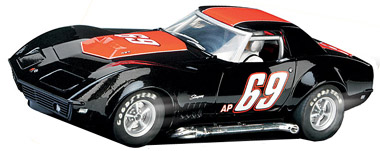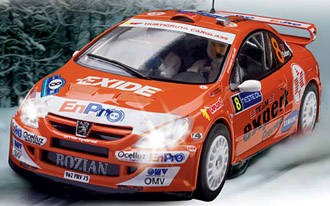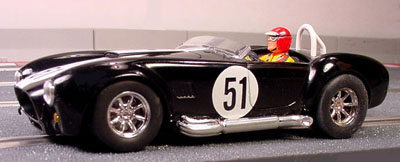New Items In Stock

Racer RCR40 Porsche 935 K3, LeMans 1980 – $265.99

Scalextric C2889 Corvette L88 vintage racing – $47.99

Scalextric C2885 Peugeot 307, H. Solberg – $47.99

SCX 62880 Williams F1, Nico Rosberg – $45.99

We all know there are lots of not-so-well designed slot cars on the market. I’m
not talking about the common gripes, such as knurled axles and press-on plastic
wheels, too-delicate wings and mirrors, or guide flags too long, thick, or deep to
fit the slots on some brands of track. Those can be aggravating, certainly, but
what I mean here is cars that have chassis, and sometimes bodies, so ineptly
designed that no amount of aftermarket parts or routine tuning will ever make
them run or handle right (and in some cases, look right). These cars need a
complete redesign. Probably every reader of this article who has been in the slot
car hobby for a while has his list of nominees for a complete makeover.
Not too long ago we heard from a customer who decided to take the car at the
top of his hopeless design list and rebuild it the way he believes it should have been made to
begin with. What’s interesting about his project is that he didn’t go the usual
route of mounting the body on a Slot It HRS chassis or replacing every moving
part on the car with NSR components. Instead, he used production replacement
parts from cars of various manufacturers, along with most of the original chassis,
to create a car that performs a whole world better than it did originally but could
have been produced in volume and sold at a normal retail price. In other words,
his redesign could have been the original design and would have performed much better. He wishes to remain anonymous in order to
avoid the possible wrath of the manufacturer, so we won’t tell you his name but
we’re going to let him tell the story…
“Have you ever taken a good look at a Ninco Cobra? The body is beautiful.
They did a great job on it, not only in modeling the overall shape but also in
capturing all the details from the raked-back windshield and the roll bar to the
side pipes and the jack brackets. But then they stuck it on top of a chassis and
running gear that somebody should have been fired for. Of course, that was
quite a few years ago, and the state of the art then wasn’t what it is now, but
even then they could have done a lot better.

For starters, that big lump of an NC2 motor, sitting approximately amidships,
weighs too much, takes up way too much space, and doesn’t leave any proper
location for a traction magnet. Of course, if you’re a rabid non-magnet zealot that
won’t matter to you, but a truly well designed chassis provides the option of
racing with or without magnets. Many non-magnet racers refit these cars with NC-1 motors to get the power down closer to what the chassis can handle.
Then there are the wheels and tires, which are grossly oversize. The wheel diameter is a scale 18.56 inches, which is about
what you’d find on a present-day tuner car, not a 60s sports car. The tires,
however, have a typical 60s profile, which means the chassis sits ridiculously
high off the track on what looks like truck tires. Finally, they put a too-deep
interior tray into the body. That meant they had to jack up the body to clear the
motor, leaving a big gap between the tires and the fenders.
The result is a car that looks like a cartoon of a Cobra or, perhaps, a Cobra set
up for offroad racing, but definitely not a proper 427 Cobra race car. It’s also a
car that essentially can’t get out of its own way on the track. It’s like a committee
hashed out the packaging of the car’s various parts on a Monday morning.
Still, that body really is nice, which set me to thinking. What if Ninco were to
redesign the chassis, fixing all the mistakes, and re-release the car? Since I had
just acquired two Ninco Cobras I decided to explore the idea. I set a goal of
making the Cobra into a car that could be both legal and competitive in my GT-1
class for 1960s and 70s SCCA production cars and sedans. This class includes
Scalextric TransAm cars and L88 Corvettes. It also allows kitbashes using the
chassis and mechanicals from these cars. The only non-stock part allowed in
this class is a pair of Indy Grips 1009 rear tires. If I could make the Cobra
competitive in this class it would mean a huge performance improvement over
the original design. Making it legal for the class would ensure that it would be a
design that could be mass-produced and sold at a reasonable price.
My first idea was simply to transplant a shortened and trimmed Scalextric
Mustang chassis into the Cobra body. The Mustang’s front and rear axle
assemblies are the perfect width to fit under the Cobra’s fenders, and the wheels,
at a scale diameter of 15.68 inches, are much closer to the proper diameter.

Size comparison between Scalextric TransAm car wheels/tires and stock Ninco Cobra wheels/tires.
However, it soon became clear that this wouldn’t work, because the Mustang’s
guide sat too far forward to clear the Cobra body’s short nose. The same proved
true of all the other possible replacement chassis I tried, including the front-motor
setup from the L88 Corvette.
My next idea was to install the complete Scalextric sidewinder setup in the
Cobra’s original chassis. The problem here was to install all the necessary motor
and axle mounts and then make them solid enough to withstand the hard knocks
of racing. Scrounging through my parts bins I found the perfect solution in the
form of a Fly sidewinder rear pod. This part goes by several different stock
numbers, including B34, B104, and B108. They are all the same except for the
color plastic they are molded in. The Scalextric motor and rear axle assembly fits
perfectly, delivering a smooth gear mesh with the stock Scalextric sidewinder
gears.

Before installing the pod I had to grind off the original Ninco motor and rear axle
mounts, along with some additional material from the chassis, using my Dremel
Moto-tool with various cutting bits. Because the chassis curves upward aft of the
rear axle I had to contour the bottom of the trailing edge of the pod to match. For
this I used my bench-mounted belt sander, but it could also be done with a
Dremel or even a file. Emery boards came in handy for cleaning up edges. I
also cut off the triangular extension from the front of the pod that includes a
mounting tab for Fly chassis and a housing for a Fly disc magnet. Since the pod
was going to be glued in the tab wasn’t needed. Also, I was going to use a
Scalextric bar magnet just forward of the motor so the disc magnet housing was
in the way and needed to go.
Once I had the pod and chassis shaped for a good, close fit I applied CA glue to
the bottom of the pod and positioned it in the chassis, clamping it in place until
the glue set. I also wanted to get rid of all the up-and-down slop in the front axle
installation, so I cut a piece of 5/32″ brass tubing and epoxied it into the chassis.
The tube also serves as a reinforcement for the guide mounting.

The next step was to snap in the motor and install the axle assemblies. A visual
check showed that the bottom of the chassis now rode at a much more
reasonable height above the track. However, when I test-fitted the Scalextric
magnet in just forward of the pod I could see that all the material I had cut away
to fit the pod in place had compromised the structural integrity of the chassis.
The magnet literally pulled the center of the chassis down to the track. Clearly,
some reinforcing was in order. I cut some small pieces of Evergreen strip
styrene and assembled them into two L-shaped structures that could be glued to
the outer portions of the chassis and to the ends of the pod to restore the lost
strength. (See photo.) Of course, a chassis molded in one piece with the pod as
an integral part of it wouldn’t need this.

I retained the Ninco guide and lead wires. In soldering the lead wires to the
motor I deleted the little capacitor Scalextric always ads to prevent interference
with TV signals. This component is largely redundant in the US since almost
everybody has cable.
In order to mount the body the interior tray had to come out and with it came the
windshield, roll bar, and gas cap. The body posts needed to be shortened to get
the body snuggled down over the wheels and tires where it belongs. The rear
ones only needed to have about 1/16″ taken off, while the front ones had to lose
about 1/8″. I also had to trim about 1/16″ off the top edge of the vertical panel at
the front of the chassis that carries the radiator screen detail. I actually cut too
much off the posts, which is why you see washers glued to the chassis in the
photos.
With the body now sitting properly on the chassis the interior tray no longer fit
over the motor. I cut out just enough of it to clear the motor and pod and used
Evergreen sheet styrene to make a boxlike structure to fill in the opening, as
shown in the photos.

I painted the new portion of the tray black to match the rest of the interior. I could
no longer use the original driver figure, so I scrounged through my parts boxes
for a lower-profile driver that would fit on top of the modified interior tray and still
not stick up above the roll bar. I finally used the arms and shoulders of one
figure and the head of another to make a driver that not only fit the space but
also looked period correct.

I also made two other modifications that weren’t essential but enhanced the car’s
appearance and functionality. I cut the windshield down to less than half its
original height, as was common practice on SCCA production sports cars back in
the 60s. This gives the car a more authentic race car look and also makes the
windshield much less vulnerable in crashes. I also replaced the roll bar with a
new one made of a Plastruct product that consists of 1/16″ diameter styrene
tubing with steel wire inside it. The new roll bar is bulletproof and looks a little
heftier than the original, which I thought looked a bit on the spindly side of scale.
On the track the rebuilt Cobra is much faster and better handling than before,
even without the magnet. With the magnet and the Indy Grips it’s fully
competitive in my GT1 class and a lot of fun to race, the magnet increasing its
limits without sticking it down so much it becomes boring to drive. It actually
drives very much like a non-magnet car with very high cornering limits.

Best of all, the car looks like a 427 Cobra should – low, wide, and aggressive
with the wheels tucked up into the fenders and the revised windshield and roll bar
providing just the right competition car touches.

There is nothing I’ve done to the car that Ninco couldn’t incorporate into a revised
version of the car for sale today. In fact, what I’ve really done is rebuild the car the way
Scalextric would have done it. In the process, I’ve given it the same excellent
out-of-the-box driving qualities that make Scalextric cars so good for giving new
hobbyists the best possible experience with the hobby and brought it up to a level
of performance fit for a model of one of the fiercest production sports cars ever
raced. Perhaps it’s time for all the slot car manufacturers to take another look at
their earlier creations and see if they could be reissued in new and improved
versions.”
Well, that’s our customer’s story. Your opinions may vary. If you want to do this
project yourself we have the cars and all the parts you need right here at Electric
Dreams. And, of course, this article will probably give you new ideas of your
own. That’s one of the things that make this hobby so much fun.
Have you done a car building project you are especially proud of? Send us some photos and a description of what you’ve done at support@electricdreams.com , and watch for your car to appear in a future newsletter.
Thanks for shopping with us!
The Electric Dream Team




